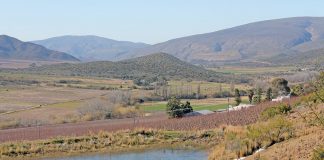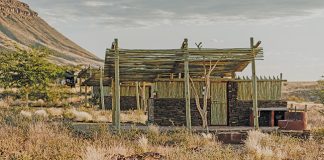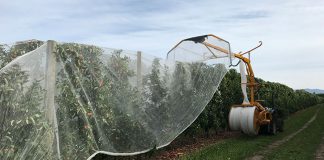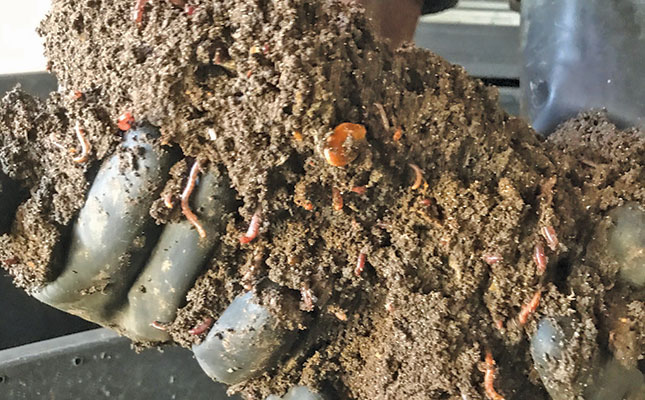
Photo: Siyanda Sishuba
Vermicast (worm castings or manure) is one of the richest natural fertilisers available. It contains the nutrients nitrogen, phosphorus and potassium, amongst others, and is highly beneficial to soil and plant life. Vermicast also improves soil structure, which helps retain moisture in the soil.
So says Thato Lekonyane, a self-taught worm farmer who runs Daddy’s Worm Farm, based at Kwalata Adventure Camp in Hammanskraal.
READ Poultry litter to biogas: adding more value to farm waste
The farm is operated as a recycling programme for food waste, and Lekonyane also hosts groups of schoolchildren to teach them about the importance of recycling in the food value chain.
An early interest in farming
Lekonyane grew up in Nokaneng village in Nkangala District Municipality, Mpumalanga, where he lived with his grandparents, Moses and Mary Ntlhoro, until he matriculated in 2008. His grandfather was a pig and cattle farmer and sparked Lekonyane’s interest in agriculture.
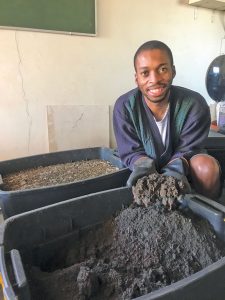
In 2009, Lekonyane moved to Kanana in Hammanskraal, where he currently lives with his parents, to do an electrical engineering course. Financial problems, however, forced him to give up his studies and look for employment.
In his search for work, he began considering different farming ventures. While researching poultry farming, he stumbled across an article on crops that mentioned earthworm farming.
“The farmer in the article explained how to breed worms and how he used them to create his own fertiliser,” he recalls.
Lekonyane started researching vermiculture and composting, discovered its role in the green economy, and learnt the basics of how to establish a worm farm.
‘’I started my worm farm in early 2017, hoping this would serve as a stepping stone towards a career in agriculture, as I lacked the resources to pursue more popular forms of farming. I just took a leap of faith.”
How it works
In earthworm farming, the worms are fed litchen waste and other organic matter. Their vermicast is then collected for use as a nutrient-rich compost for crops. The worms are housed in containers or improvised structures; Lekonyane has set up four plastic bins.
Like most worm farmers, he uses red wiggler worms (Eisenia fetida), as they thrive in compost.
READ R6 billion investment boosts world’s largest insect farm
‘’Before creating a habitat for the worms, I’d carried out some research, and this confirmed that worms require nitrogen and carbon in their diet,” he says.
“The kitchen waste that I use provides these, as well as the other nutrients they require.”
Initially, Lekonyane used only kitchen waste, which included eggshells, egg cartons, vegetable and fruit scraps. However, the moisture level of this habitat was too low, and some of the worms escaped from the bins to seek moisture. They rapidly dried out and died, however.
Lekonyane turned to worm farmer Joe Weetman of Lynnwood in Pretoria for guidance.
“I had seen his compost at a hardware store, so contacted him. He advised me to add cow manure to provide more moisture in the worm habitat.
“Adding cow manure to the habitat brought sustainable moisture and stability. I started seeing real progress and was able to expand the farm in 2018,” says Lekonyane.
A balanced diet for the worms
The material fed into the farm now also includes sawdust and used tea bags. Sawdust and egg cartons are rich in carbon and also helps absorb excess moisture, while tea adds nitrogen and helps the habitat to attract mould more efficiently.
Cow manure, apart from increasing moisture levels, also adds nitrogen.
Eggshells provide calcium as well as helping to neutralise the acids created by the fruit and vegetable waste.
“A diverse diet increases the quality of compost, as it adds a variety of nutrients,” says Lekonyane, adding that all ingredients need to be crushed before being added to the bins.
He minimises the use of citrus fruit, which is highly acidic, and potatoes, which contain the toxin solanine.
Trial and error
According to Lekonyane, worms favour a temperature of between 15˚C and 30˚C. Their habitat should be consistently dark and moist, so that its contents attract mould, which assists the worms in breaking down the waste.
Because the worms require oxygen, the lid of the bin must have breathing holes. Holes should also be drilled at the bottom of the bin to enable excess moisture to drain out, and the bins placed on a raised platform.
Lekonyane explains that as the worms reproduce rapidly, he has to ensure that the bins do not become overpopulated.
It took about 11 months of trial and error before he harvested his first compost.
“Early in 2019, I started looking for a market in my neighbourhood, as there are many people here with gardens. I couldn’t go further than my immediate neighbourhood to distribute samples as I had no transport,” he says.
He gave out approximately 15 samples of vermicast, but only one person ended up buying some compost.
Harvesting
To harvest the vermicast, Lekonyane initally emptied the fully processed contents of the bins in direct sunlight and created a number of pyramid-shaped compost heaps.
“Because worms are sensitive to light, they crawled to the bottom of the heap, and we scooped worm castings off the top,” he explains. “But this method was very slow, so I started using the migration harvest method.”
READ Earthworms to the rescue on degraded sugar cane land
This involves half-filling a bin with new feed ingredients, then pouring the fully processed contents of an older bin on top of the new feed mixture. After a time, the worms in the older contents of the bin migrate downwards to the new habitat in search of feed, leaving their worm castings at the top.
“This system now enables us to harvest compost every week,’’ says Lekonyane.
Recycling and education
In February 2019, Lekonyane met the owners of Kwalata Lodge, who have since provided him with a venue to sell his compost.
The lodge also has an adventure camp and the farm was invited to become part of the activities offered to groups of schoolchildren.
“Because Kwalata Lodge has a restaurant, the worm farm can recycle waste from the kitchen and run a recycling programme,” says Lekonyane.
“Collaboration with the owners of Kwalata has also opened up new ideas and possibilities in the agriculture, education, tourism and environmental sectors.”
The next step, he explains, is to find institutions and big players in these sectors to team up with, so that he can recycle waste on a larger scale.
Email Thato Lekonyane at [email protected].











